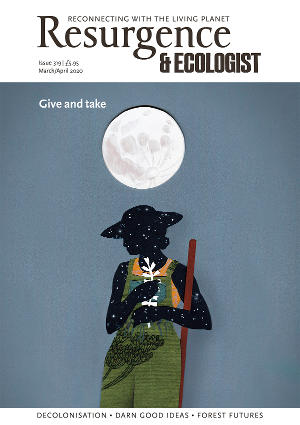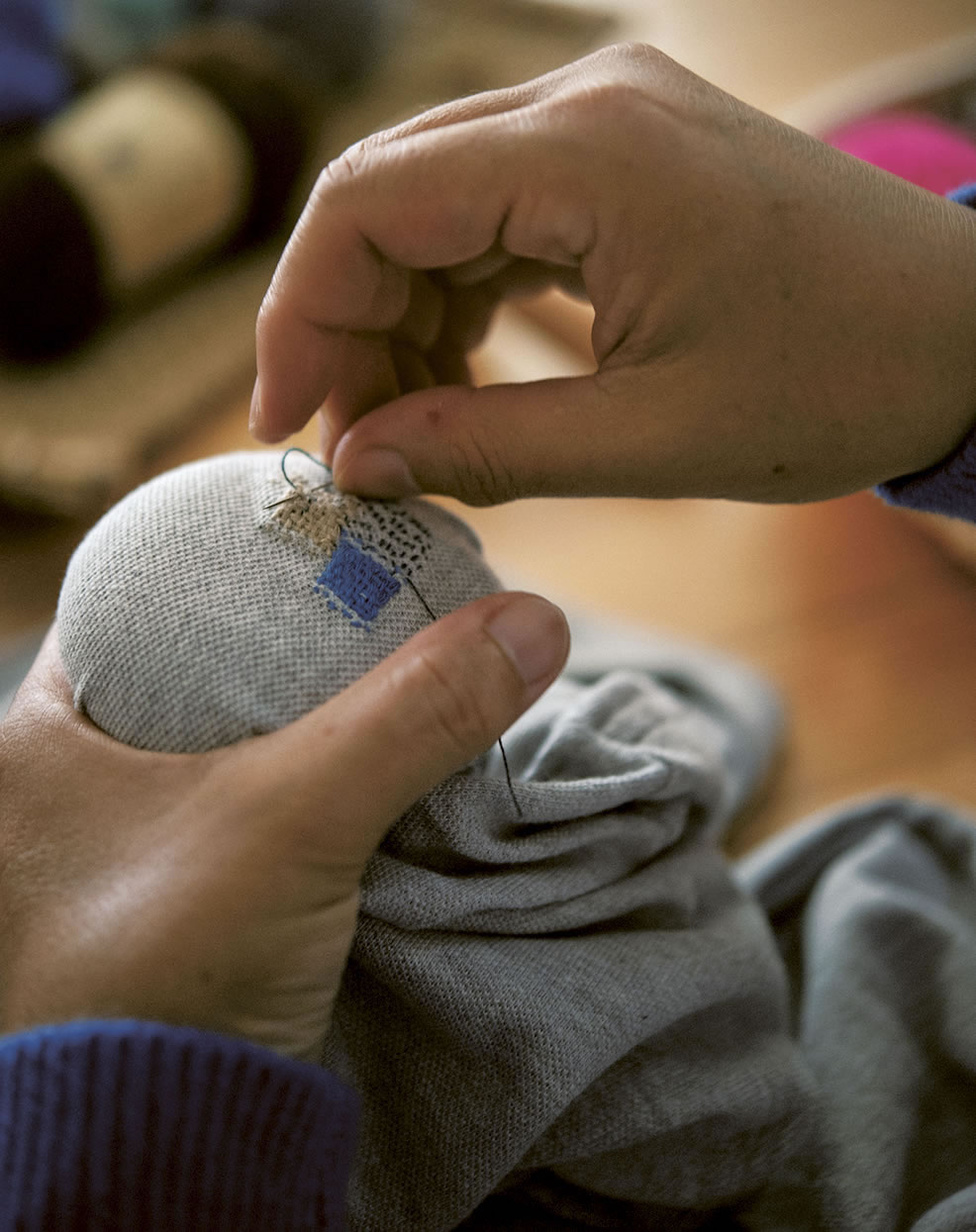There are plenty of reasons why people mend, though the stigma around repair is alive and well. Recently I mended a favourite shirt for my partner, a teacher, who was later asked by a student, “Sir, can’t you afford a new shirt?” What was once a luxury item, a new piece of clothing, has become throwaway for some, and expensive and rare yarns such as cashmere are now ubiquitous. As we offload another sack of old clothes on the charity shop to make room in our cluttered cupboards, what value are we putting on these items?
Historically a darn would have been a sign of poverty or penny-pinching, but more recently the drive for sustainability, as well as respect for makers and materials, has led to a revival in the old art of darning. Darning has a long and venerable history, not just for knitted items such as socks, but also for sheets and other domestic fabrics. The origin of the word is not clear, but may have come from the early-17th-century English word dern, meaning ‘to hide’. Perhaps this is why the art of darning is mostly unsung – because the darns were designed to be invisible.
Hand knitting can be a slow process and the items made become much treasured, so it makes sense that when small imperfections appear they are repaired. Wool is vulnerable to attack from pests, or to wear and tear, especially in the case of elbows and heels, cuffs and collars, but knitters are resourceful folk and will find ways to repair the damage by reknitting cuffs and collars and by darning. Anyone who has worn hand-knitted woollen socks will know how quickly they can wear out – I recall my mother’s seemingly endless mending pile – but now that socks are more often shop-bought than handmade, darning has become a neglected skill, and wooden mushrooms and eggs aren’t as common in sewing baskets as they once were.
However, of late, in reaction to this age of disposable fashion and built-in obsolescence, there is increased interest in using fewer resources, buying less and preserving the things we already have, and darning has begun to ‘trend’. Now darns are often not the invisible kind, but deliberately mark clothes much like a tattoo or a graffiti tag, so you can wear your social conscience on your sleeve. The skill of darning is seeing a renaissance, but this time the darns will be noticed.
In her book Darning: Repair, Make, Mend, Hikaru Noguchi reinterprets a traditional methodology with a distinctly Japanese aesthetic. She discusses English darning techniques, which she learned while living in the UK, and describes her first experience of visible mending as a “shocking experience” while visiting the ethical yarn store Prick Your Finger, opened by artist Rachael Matthews in London’s Bethnal Green in 2007. For Matthews, a long-time advocate of natural yarns and darning, mending is not just a practical necessity – it’s also about healing and loss, deciding what to save and what’s irreparable. “With a treasured garment, something that may have belonged to a loved one who is no longer with us, it is poignant to weigh the value of this broken thing, both emotionally and in monetary terms,” she says.
In many cultures, precious pieces of fabric are considered to have spiritual meaning and are passed down through the generations. These are the heirlooms that newborns are wrapped in, or bodies are shrouded in – imbued with the spirit of those who wore them. “Once repaired, the garment becomes more precious, as value and energy are added by the attention it has received: by mending these pieces we are contributing our own spirit and energy,” Matthews continues. “It’s not just about mending the cloth, but about repairing a damaged memory at the same time.”
Darning techniques have become reciprocal between these two women. “I’ve mended things since I learned to sew as a child, and I thought I knew my stuff,” says Matthews, “but everything changed when Hikaru Noguchi invited me to Japan to host a darning workshop alongside the launch of her book. Hikaru teaches that techniques of mending are never-ending. We love to mend because we don’t want things to end, but as menders we continue to have new beginnings, just like the garments do. We are continually free to find new ways of doing things.”
Tom van Deijnen – known as Tom of Holland – is a knitter with a passion for mending. His aim is to inspire people to ‘upskill’ themselves and learn how to take care of their knits. He is interested in the stories behind the garments that come his way: who they belonged to and how they became damaged. He explains that by exploring the motivations for repair, the emphasis shifts from the new and perfect to the old and imperfect, highlighting the relationship between garment and wearer. Tom has undertaken several commissions to fix treasured garments, one of which was for a woman named Bernadette whose jumper had been knitted by her mother, who had since passed away. The jumper needed sensitive reconstruction. As is current practice in historical restoration, this was done in a different colour so that it would be obvious what was the repair and what was original.
Tom has also worked to highlight the traditional skill of darning in samplers – once as prized as embroidery and often just as decorative. Using a vintage Speedweve darner, a device like a small loom that lifts the ends of threads, he has been able to make delightfully intricate patterns. Tom also collects and replicates historical darning samplers from the 1700s, some of which show examples of linen darning, including beautiful twill and damask darning techniques, where a pattern is woven into the warp and weft threads.
Celia Pym, who was shortlisted for the Woman’s Hour Craft Prize, cites Noguchi’s work as influential to her. Pym is interested in a garment’s damage – how the damage was made, and why – and her pieces typically have more darn than substance, giving rise to the question of whether it is still the same garment if most of the material is replaced. In 2014, Pym worked with Richard Wingate in the Dissecting Room at King’s College London as part of the project Parallel Practices, a partnership between by the Crafts Council and the Cultural Institute at King’s College. Out of this collaboration rose A Mending Project, which looked at the often uncomfortable parallels between an ageing garment and the body that inhabited it, both suffering the ravages of time. Between the mending and the studying there were conversations about the generosity of donors who give their bodies to science, about respect for the fabric of people’s bodies, and about healing and reconstruction – how some things that are broken can be repaired, while others cannot. The parallels with putting together a fragmented body or mind become apparent in the quiet time and reflection that slow making allows.
The visible-mending movement is reclaiming darning. Rather than a sign of poverty, darns are now being worn as a badge of honour and skill, saving more of our clothes from the rag pile. Mending, darning and repairing are radical acts of self-care and planetary care; they are works of art that weave together the stories of our lives. It is essential work that people like Hikaru Noguchi, Rachael Matthews, Tom van Deijnen and Celia Pym do with grace and beauty.
Inspired by this article to revive a worn item of clothing? Then try your hand at seed stitch. You can find instructions here:
Darning Method: /magazine/extras/319/Article-5503-Seed-Square-Darning-Method.pdf
Seed Stitch Detail: /magazine/extras/319/Article-5503-Seed-Stitch.pdf
Photocredit for main image: Hikaru’s hands darning. Photograph by Noriaki Moritani








